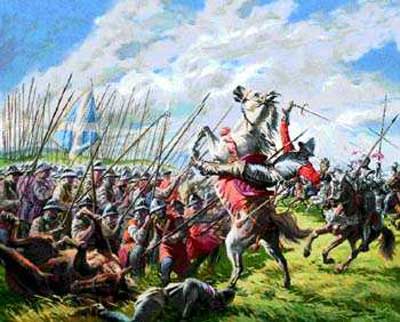
Like their English counterparts, Scottish kings had recourse to feudal service obligations of an enfeoffed nobility. In addition, there was a tradition of communal military service among the free male population known as ‘‘communis exercitus’’ or the ‘‘servitium scottianum.’’ During and after the Scottish Wars of the 13th–14th centuries, Scotland cleaved to the ‘Auld alliance with France, which presented a natural alliance out of mutual propinquity to a common enemy. That proved of little worth at Flodden Field (1513) where an English army sent north by the young Henry VIII defeated the Scots, who lost their young king, James IV (1488–1513), and many lairds and clansmen that day. Another day of defeat and despair came in 1547, at Pinkie Cleugh. The association with France was temporarily strengthened by England’s turn toward the reformed religion under Henry and then Elizabeth I, which alienated Catholics in Scotland and France who shared ties of kinship and faith through Mary Stuart and the Guise. It broke down, however, as more Scots converted to a severe version of the new religion during the full-throated Protestant Reformation. The dour preachings of John Knox and the new national faith of the Covenanters reshaped the Church in Scotland into the Presbyterian Kirk. The historical prop of the ‘Auld alliance and French support of Scottish political independence was kicked away.
Matters came to a head during the reign of Elizabeth I and the interrupted reign of Mary Stuart, who was supported by Catholic powers in her claim to the Scottish and English thrones but was opposed by many of her Scottish subjects for her Catholic faith and ties to foreign powers. Elizabeth kept the fires of dissent alive with money and subversion of Scottish political stability. In the end, Mary Stuart lost the Scottish throne and her personal freedom (1567), then her life to an English executioner (1587). Her son was elevated as James VI of Scotland (1566–1625) and later as James I of England (1567– 1625), mounting the southern throne after the childless Elizabeth died in 1603. This union of crowns between England and Scotland brought peace along the border. However, trouble lay ahead: the Lowlands accepted union with the ancient enemy, to which the Lords had grown closer and more alike over the centuries from shared holdings on either side of the Tweed; but the Highlands remained wild, hardly governed at all, and fiercely independent and resentful of England.
For a time this social and cultural division among Scots was obscured by the dominance of the religious question in Scottish and international politics. During the Thirty Years’ War large numbers of Scots served as mercenaries in various armies. Arcane doctrinal and ecclesiastical disputes pulled Scotland deep into the English Civil Wars (1639–1651) as Scottish nobles and Covenanters backed the English king, Charles I, then betrayed him to Parliament, then fought Parliament and the military dictator, Oliver Cromwell. Following losses at Dunbar (1650) and Worcester (1651), thousands of Scots prisoners were transported to the West Indies as indentured laborers and Scotland became permanently subservient to England.
Suggested Reading: I. Cowen, The Scottish Reformation (1978); David Stevenson, The Scottish Revolution, 1637–1644 (1973).